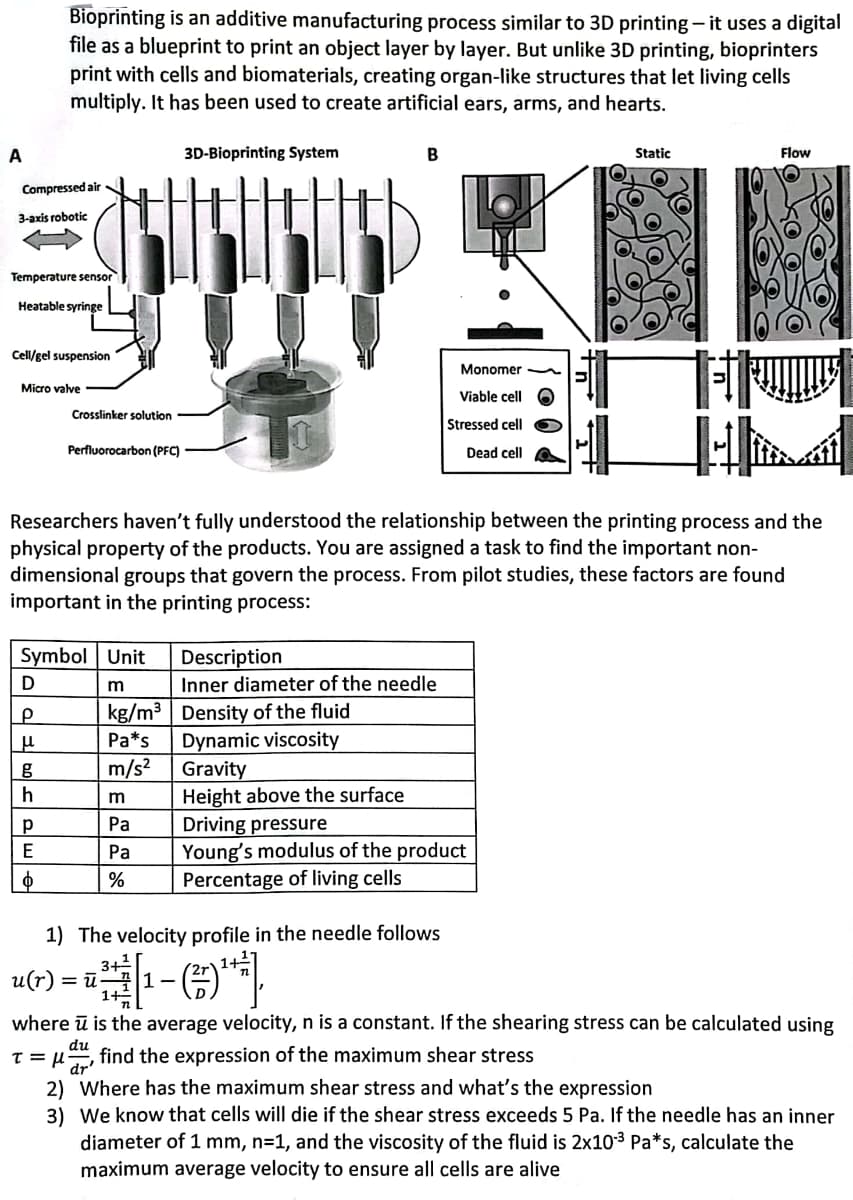eprint to print an object la cells and biomaterials, crea
Introduction to Chemical Engineering Thermodynamics
8th Edition
ISBN:9781259696527
Author:J.M. Smith Termodinamica en ingenieria quimica, Hendrick C Van Ness, Michael Abbott, Mark Swihart
Publisher:J.M. Smith Termodinamica en ingenieria quimica, Hendrick C Van Ness, Michael Abbott, Mark Swihart
Chapter1: Introduction
Section: Chapter Questions
Problem 1.1P
Related questions
Question
Please solve complete

Transcribed Image Text:A
Compressed air
3-axis robotic
Temperature sensor
Heatable syringe
Bioprinting is an additive manufacturing process similar to 3D printing - it uses a digital
file as a blueprint to print an object layer by layer. But unlike 3D printing, bioprinters
print with cells and biomaterials, creating organ-like structures that let living cells
multiply. It has been used to create artificial ears, arms, and hearts.
3D-Bioprinting System
Cell/gel suspension
Micro valve
D
P
|__μ
g
h
Р
Crosslinker solution
Symbol Unit
m
kg/m³ Density of the fluid
Pa*s Dynamic viscosity
Gravity
m/s²
E
Ф
Perfluorocarbon (PFC)
4 HE
Researchers haven't fully understood the relationship between the printing process and the
physical property of the products. You are assigned a task to find the important non-
dimensional groups that govern the process. From pilot studies, these factors are found
important in the printing process:
m
Pa
Pa
%
B
3+²
=ū-11-
Description
Inner diameter of the needle
Height above the surface
Monomer
Viable cell
Stressed cell
Dead cell
1) The velocity profile in the needle follows
-(¹)
Driving pressure
Young's modulus of the product
Percentage of living cells
Static
Flow
u(r)
where ū is the average velocity, n is a constant. If the shearing stress can be calculated using
du
T = μ find the expression of the maximum shear stress
dr'
2)
Where has the maximum shear stress and what's the expression
3) We know that cells will die if the shear stress exceeds 5 Pa. If the needle has an inner
diameter of 1 mm, n=1, and the viscosity of the fluid is 2x10-³ Pa*s, calculate the
maximum average velocity to ensure all cells are alive
Expert Solution
This question has been solved!
Explore an expertly crafted, step-by-step solution for a thorough understanding of key concepts.
Step by step
Solved in 4 steps with 4 images

Recommended textbooks for you

Introduction to Chemical Engineering Thermodynami…
Chemical Engineering
ISBN:
9781259696527
Author:
J.M. Smith Termodinamica en ingenieria quimica, Hendrick C Van Ness, Michael Abbott, Mark Swihart
Publisher:
McGraw-Hill Education

Elementary Principles of Chemical Processes, Bind…
Chemical Engineering
ISBN:
9781118431221
Author:
Richard M. Felder, Ronald W. Rousseau, Lisa G. Bullard
Publisher:
WILEY

Elements of Chemical Reaction Engineering (5th Ed…
Chemical Engineering
ISBN:
9780133887518
Author:
H. Scott Fogler
Publisher:
Prentice Hall

Introduction to Chemical Engineering Thermodynami…
Chemical Engineering
ISBN:
9781259696527
Author:
J.M. Smith Termodinamica en ingenieria quimica, Hendrick C Van Ness, Michael Abbott, Mark Swihart
Publisher:
McGraw-Hill Education

Elementary Principles of Chemical Processes, Bind…
Chemical Engineering
ISBN:
9781118431221
Author:
Richard M. Felder, Ronald W. Rousseau, Lisa G. Bullard
Publisher:
WILEY

Elements of Chemical Reaction Engineering (5th Ed…
Chemical Engineering
ISBN:
9780133887518
Author:
H. Scott Fogler
Publisher:
Prentice Hall


Industrial Plastics: Theory and Applications
Chemical Engineering
ISBN:
9781285061238
Author:
Lokensgard, Erik
Publisher:
Delmar Cengage Learning

Unit Operations of Chemical Engineering
Chemical Engineering
ISBN:
9780072848236
Author:
Warren McCabe, Julian C. Smith, Peter Harriott
Publisher:
McGraw-Hill Companies, The